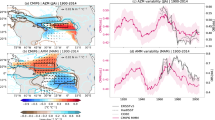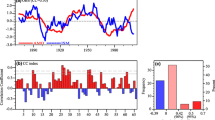Abstract
This paper investigates the influence of the tropical Atlantic on the tropical Pacific interannual variability and mean state in the twentieth century. It is demonstrated that observational datasets show a significant time-delayed impact of the tropical Atlantic on tropical Pacific sea surface temperatures, leading to an anticorrelation between the tropical Atlantic and the eastern Pacific if the Atlantic is leading by about 10 months. This result is robust across different sea surface temperature reconstructions. There is no robust correlation between the tropical Atlantic and the eastern Pacific when the Pacific is leading, although in recent decades a positive correlation between the two basins is more dominant. An analysis of the surface pressure response to the tropical Atlantic indicates an atmospheric bridge and a modification of the Walker circulation as the likely trigger for the teleconnection, and this result is consistent with recent observational and modelling results for the recent decades. 30 out of the analyzed 45 World Climate Research Program’s Coupled Model Intercomparison Project Phase 5 (CMIP5) models show statistically significant anticorrelations between individual tropical Atantic warm and cold events and the time-lagged eastern Pacific sea surface temperatues. 16 out of the 45 analyzed models fulfill the more stringent criterion of lead–lag correlations between the tropical Atlantic and Pacific similar to the observations. The atmospheric bridge mechanism seems also valid in the selected CMIP5 models. We have identified the tropical Atlantic warm bias present in nearly all models as one potential candidate for the overall weak time-delayed teleconnection between the tropical Atlantic and the Pacific, but also other mean state biases are important. In the selected models a stronger warming of the tropical Atlantic Ocean compared to the global sea surface temperature mean is associated with a La Nina-like mean state change in the tropical Pacific. However, the ensemble mean of these models still shows a weakly El Nino-like trend, which is associated with a relatively weak Atlantic warming compared to the global mean and the observations.












Similar content being viewed by others
References
Barimalala R, Bracco A, Kucharski F (2012) The representation of the South Tropical Atlantic teleconnection to the Indian Ocean in the AR4 coupled models. Clim Dyn 38:1147–1166. doi:10.1007/s00382-011-1082-5
Bellenger H, Guilyardi E, Leloup J, Lengaigne M, Vialard J (2013) ENSO representation in climate models: from CMIP3 to CMIP5. Clim Dyn. doi:10.1007/s00382-013-1783-z
Chang P, Fang Y, Saravannan R, Li L, Seidel H (2006) The cause of the fragile relationship between the Pacific El Nino and the Atlantic El Nino. Nature 443:324–328
Chen D, Cane MA, Kaplan A, Zebiak ZE, Huang D (2004) Predictability of El Nino over the past 148 years. Nature 428:733–736. doi:10.1038/nature02439
Chikamoto Y, Kimoto M, Watanabe M, Ishii M, Mochizuki T (2012) Relationship between the Pacific and Atlantic stepwise climate change during the 1990s. Geophys Res Lett doi:10.1029/2012GL053901
Collins M et al. (2010) The impact of global warming on the tropical Pacific Ocean and El Nino. Nat Geosci 3. doi:10.1038/ngeo868
Compo GP, Sardeshmukh PD (2010) Removing ENSO-related variations from the climate record. J Clim 23:1957–1978
Compo GP et al (2011) The 20th century reanalysis project. Q J R Meteorol Soc 137:1–28. doi:10.1002/qj.776
Ding H, Keenlyside NS, Latif M (2012) Impact of the equatorial Atlantic on the El Nino Southern Oscillation. Clim Dyn 38:1965–1972. doi:10.1007/s00382-011-1097-y
Dommenget D, Semenov V, Latif M (2006) Impacts of the tropical Atlantic and Indian Ocean on ENSO. Geophys Res Lett 33:L11701. doi:10.1029/2006GL025871
Dong BW, Sutton RT (2007) Enhancement of El Nino-Southern Oscillation (ENSO) variability by a weakened Atlantic thermohaline circulation in a coupled GCM. J Clim 20:4920–4939
Duan W, Wei C (2012) The ‘spring predictability barrier’ for ENSO predictions and its possible mechanism: results from a fully coupled model. Int J Clim. doi:10.1002/joc3513
Evan AT, Vimont DJ, Heidinger AK, Kossin J, Bennetz R (2009) Evolution of tropical North Atlantic Ocean temperature anomalies. Science 324:778. doi:10.1126/science.1167404
Frauen C, Dommenget D (2012) Influences of the tropical Indian and Atlantic Oceans on the predictability of ENSO. Geophys Res Lett 39:L02706. doi:10.1029/2011GL050520
Guilyardi E et al (2012) A first look at ENSO in CMIP5. Clivar Exch 17:29–32
Ham Y-Y, Kug J-S, Park JY, Jin F-F (2013a) Sea surface temperature in the north tropical Atlantic as a trigger for El Niño/Southern Oscillation events. Nat Geosci. doi:10.1038/NGEO1686
Ham Y-Y, Kug J-S, Park JY, Jin F-F (2013b) Two distinct roles of Atlantic SSTs in ENSO variability: north tropical Atlantic SST and Atlantic Nino. Geophys Res Lett 40:4012–4017. doi:10.1002/grl50729
Izumo T, Vialard J, Lengaigne M, de Boyer Montegut C, Behera SK, Luo JJ, Cravatte S, Masson S, Yamagata T (2010) Influence of the state of the Indian Ocean Dipole on the following year’s El Nino. Nat Geosci 3:168–172. doi:10.1038/ngeo760
Jansen MF, Dommenget D, Keenlyside N (2009) Tropical atmosphere–ocean interactions in a conceptual framework. J Clim 22:550–567. doi:10.1175/2008JCLI2243.1
Jha B, Hu Z-Z, Kumar A (2013) SST and ENSO variability and change simulated in historical experiments of CMIP5 models. Clim Dyn. doi:10.1007/s00382-013-1803-z
Kalnay E et al (1996) The NCEP/NCAR 40-year reanalysis project. Bull Am Meteorol Soc 77:437–471
Keenlyside NS, Ding H, Latif M (2013) Potential of equatorial Atlantic variability to enhance El Nino prediction. Geophys Res Lett 40:2278–2283. doi:10.1002/grl.50362
Kucharski F, Kang I-S, Farneti R, Feudale L (2011) Tropical Pacific response to 20th century Atlantic warming. Geophys Res Lett 38:L03702. doi:10.1029/2010GL046248
L’Heureux ML, Lee S, Lyon B (2013) Recent multidecadal strengthening of the Walker circulation across the tropical Pacific. Nat Clim Chang. doi:10.1038/NCLIMATE1840
Lu R, Chen W, Dong B (2008) How does a weakened Atlantic thermohaline circulation lead to an intensification of the ENSO-south Asian summer monsoon interaction? Geophys Res Lett 35:L08706. doi:10.1029/2008GL033394
Martin-Rey M, Polo I, Rodriguez-Fonseca B, Kucharski F (2012) Changes in the interannual variability of the tropical Pacific as a response to an equatorial Atlantic forcing. Scientia Marina 76(S1). doi:10.3989/scimar.03610.19A
Parker D, Folland C, Scaife A, Knight J, Colman A, Baines P, Dong B (2007) Decadal to multidecadal variability and the climate change background. J Geophys Res 112:D18115
Rayner NA, Parker DE, Horton EB, Folland CK, Alexander LV, Rowell DP, Kent EC, Kaplan A (2003) Global analyses of sea surface temperature, sea ice, and night marine air temperature since the late nineteenth century. J Geophys Res 108. doi:10.1029/2002JD002670
Reynolds RW, Rayner NA, Smith TM, Stokes DC, Wang W (2002) An improved in situ and satellite SST analysis for climate. J Clim 15:1609–1625
Richter I, Xie S-P, Behera SK, Doi T, Masumoto Y (2014) Equatorial Atlantic variability and its relation to mean state biases in CMIP5. Clim Dyn 42:171–188. doi:10.1007/s00382-012-1624-5
Rodriguez-Fonseca B, Polo I, Garcia-Serrano J, Losada T, Mohino E, Mechoso CR, Kucharski F (2009) Are Atlantic Ninos enhancing Pacific ENSO events in recent decades? Geophys Res Lett 36:L20705. doi:10.1029/2009GL040048
Smith TM, Reynolds RW (2004) Improved extended reconstruction of SST (1854–1997). J Clim 17:2466–2477
Solomon A, Newman M (2012) Reconciling disparate 20th century Indo-Pacific ocean temperature trends in the instrumental record. Nat Clim Chang 2:691–699
Taylor KE, Stouffer RJ, Meehl GA (2012) An overview of CMIP5 and the experimental design. Bull Am Meteorol Soc 93:485–498. doi:10.1175/BAMS-D-00094.1
Uppala S et al (2005) The ERA-40 re-analysis. Q J R Meteorol Soc 135:1830–1841
Vecchi GA, Clement A, Soden BJ (2008) Examining the tropical Pacific’s response to global warming, EOS Trans AGU 89(9). doi:10.1029/2008EO0900002
Wang C, Kucharski F, Barimalala R, Bracco A (2009) Teleconnections of the tropical Atlantic to the tropical Indian and Pacific Oceans: a review of recent findings. Meteorol Z 18:445–454. doi:10.1127/0941-2948/2009/0394
Weare BC (2013) ENSO modes of the equatorial Pacific Ocean in observations and CMIP5 models. Clim Dyn. doi:10.1007/s00382-013-1941-3
Wright PB (1986) Precursors of the Southern Oscillation. J Climatol 6:17–30
Yeh SW, Ham Y-G, Lee J-Y (2012) Changes in the tropical Pacific SST trend from CMIP3 to CMIP5 and its implications for ENSO. J Clim 25:7764–7771. doi:10.1175/JCLI-D-12-00304
Zhang R, Delworth TL (2007) Impact of the Atlantic multidecadal oscillation on north pacific climate variability. Geophys Res Lett 34:L23708
Acknowledgments
The authors with to thank the two anonymous reviewers for their constructive suggestions to improve the manuscript. We thank also Waheed Iqbal for technical support in analyzing the data. We acknowledge the World Climate Research Programme’s Working Group on Coupled Modelling, which is responsible for CMIP, and we thank the climate modeling groups (listed in Table 1 of this paper) for producing and making available their model output. For CMIP the US Department of Energy’s Program for Climate Model Diagnosis and Intercomparison provides coordinating support and led development of software infrastructure in partnership with the Global Organization for Earth System Science Portals. We also acknowledge observational reconstructions provided by ECMWF, NOAA, NCEP/NCAR, and the Hadley Center.
Author information
Authors and Affiliations
Corresponding author
Electronic supplementary material
Below is the link to the electronic supplementary material.
Rights and permissions
About this article
Cite this article
Kucharski, F., Syed, F.S., Burhan, A. et al. Tropical Atlantic influence on Pacific variability and mean state in the twentieth century in observations and CMIP5. Clim Dyn 44, 881–896 (2015). https://doi.org/10.1007/s00382-014-2228-z
Received:
Accepted:
Published:
Issue Date:
DOI: https://doi.org/10.1007/s00382-014-2228-z




